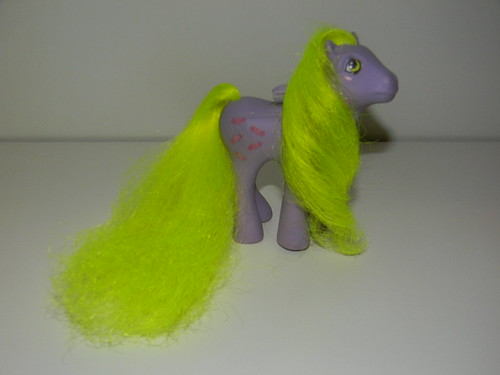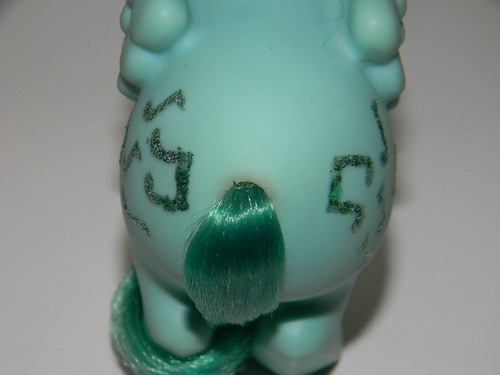Ah, the First World problems of a Collector. Those of us who collect
vintage (and modern) toys tend to get a little obsessive about flaws,
problems, and wear. What can we live with, what won't we allow across
the threshold of the Pony Room?
The unfortunate truth
about vintage Ponies is that very few of these 30+ year old toys has
made it this far without sustaining some kind of damage. The even more
unfortunate truth is that we're only going to see more damage coming out
on these beloved friends as time passes. In the next few weeks, I'm
going to explore some of the more common problems that we see in vintage
ponies, with an eye toward educating new collectors and warning FIM
fans about what they might expect from their Ponies in the coming years.
Frizz
Nylon hair that has been brushed, washed, and generally played with repeatedly can become damaged and frizzy. This is especially common on ponies that were sold with curly hair. Sometimes you look at a pony with frizzy hair and think it's a lost cause, but I've found that it's always good to try and repair her anyway, sometimes you'll be surprised at the results.
Washing and conditioning the hair is a good first step. Often, you'll begin to see improvement right away with just the first application of conditioner. If the hair is quite damaged, it may be worthwhile to leave the conditioner on for a prolonged period, perhaps even several days. If you are still not happy with the state of the hair, it is possible to improve it further using a straightening iron. It is important to keep the hair wet and full of conditioner, and to use a low heat setting for there is a danger that the hair could burn. Some Nirvana ponies have particularly brittle hair, so this step might not always be a good idea. Another option is to curl the hair, as this can help to hide some of the frizziness. And, of course, rehairing is also an option if the hair cannot be saved.
Rust
Rust
can be a common problem on any generation of pony. Most commonly, the
metal washer and clamp that hold the tail in place will rust when they
get wet. If left untreated, the washer can actually rust to the point
where it disintegrates. The evidence of rust can often be seen on the
outside of the pony, where the body and hair have become discoloured, as
can be seen above. The rust can even spread throughout the body,
causing the pony to appear dingy or discoloured from the outside.
The
best treatment for rust is to remove the rusty washer and clamp.
Toothpaste, especially whitening toothpaste, is a good cleaning agent,
but keep in mind that it can cause the hair to discolour, especially
fading pink hair. Be sure to clean right down into the feet using a
bottle brush or q-tip. Allow the pony to dry thoroughly before putting
her back together, so you can avoid further issues down the road. A
plastic zip-tie or similar device can replace the washer and clamp, and
won't cause rust issues later.
Discolouration
Some
of the brighter colours of hair can cause discolouration to the body of
the pony. The Chartreuse colour above is especially bad for this.
Dry, it is normally fairly safe, but as soon as it gets wet the colour
becomes unstable and it can bleed. The dye can quickly stain the body,
so it is important to ensure that the wet hair does not sit directly
against the body, place a few layers of paper towel between the body and
hair to prevent damage.
As I mentioned above, this
"Electric Banana" colour is fairly safe when dry, but it can discolour
the body around the tail hole and hair plugs simply through prolonged
contact. What initially appears to be the reflection of the bright
colour against the body can prove to be discolouration. This type of
discolouration is minor and difficult if not impossible to repair.
However, stains from the hair on other parts of the pony may be removed
through sunfading. It is important, however, to cover all parts of the
pony you do not want to fade, and to do some research in advance.
Certain ponies are prone to "burning" (turning brown) if left in the
sun.
Elf






No comments:
Post a Comment